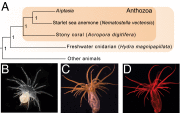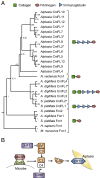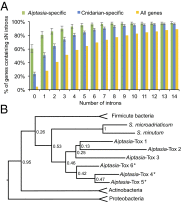The genome of Aiptasia, a sea anemone model for coral symbiosis
- PMID: 26324906
- PMCID: PMC4586855
- DOI: 10.1073/pnas.1513318112
The genome of Aiptasia, a sea anemone model for coral symbiosis
Abstract
The most diverse marine ecosystems, coral reefs, depend upon a functional symbiosis between a cnidarian animal host (the coral) and intracellular photosynthetic dinoflagellate algae. The molecular and cellular mechanisms underlying this endosymbiosis are not well understood, in part because of the difficulties of experimental work with corals. The small sea anemone Aiptasia provides a tractable laboratory model for investigating these mechanisms. Here we report on the assembly and analysis of the Aiptasia genome, which will provide a foundation for future studies and has revealed several features that may be key to understanding the evolution and function of the endosymbiosis. These features include genomic rearrangements and taxonomically restricted genes that may be functionally related to the symbiosis, aspects of host dependence on alga-derived nutrients, a novel and expanded cnidarian-specific family of putative pattern-recognition receptors that might be involved in the animal-algal interactions, and extensive lineage-specific horizontal gene transfer. Extensive integration of genes of prokaryotic origin, including genes for antimicrobial peptides, presumably reflects an intimate association of the animal-algal pair also with its prokaryotic microbiome.
Keywords: coral reefs; dinoflagellate; endosymbiosis; horizontal gene transfer; pattern-recognition receptors.
Conflict of interest statement
The authors declare no conflict of interest.
Figures





Similar articles
-
Developing the anemone Aiptasia as a tractable model for cnidarian-dinoflagellate symbiosis: the transcriptome of aposymbiotic A. pallida.BMC Genomics. 2012 Jun 22;13:271. doi: 10.1186/1471-2164-13-271. BMC Genomics. 2012. PMID: 22726260 Free PMC article.
-
Generation and analysis of transcriptomic resources for a model system on the rise: the sea anemone Aiptasia pallida and its dinoflagellate endosymbiont.BMC Genomics. 2009 Jun 5;10:258. doi: 10.1186/1471-2164-10-258. BMC Genomics. 2009. PMID: 19500365 Free PMC article.
-
Aiptasia sp. larvae as a model to reveal mechanisms of symbiont selection in cnidarians.Sci Rep. 2016 Sep 1;6:32366. doi: 10.1038/srep32366. Sci Rep. 2016. PMID: 27582179 Free PMC article.
-
Cell Biology of Coral Symbiosis: Foundational Study Can Inform Solutions to the Coral Reef Crisis.Integr Comp Biol. 2019 Oct 1;59(4):845-855. doi: 10.1093/icb/icz067. Integr Comp Biol. 2019. PMID: 31150064 Review.
-
Coral evolutionary responses to microbial symbioses.Philos Trans R Soc Lond B Biol Sci. 2020 Sep 28;375(1808):20190591. doi: 10.1098/rstb.2019.0591. Epub 2020 Aug 10. Philos Trans R Soc Lond B Biol Sci. 2020. PMID: 32772672 Free PMC article. Review.
Cited by
-
Presence of algal symbionts affects denitrifying bacterial communities in the sea anemone Aiptasia coral model.ISME Commun. 2022 Oct 28;2(1):105. doi: 10.1038/s43705-022-00190-9. ISME Commun. 2022. PMID: 37938763 Free PMC article.
-
High-Quality Genome Assembly of Chrysaora quinquecirrha Provides Insights Into the Adaptive Evolution of Jellyfish.Front Genet. 2020 Jun 4;11:535. doi: 10.3389/fgene.2020.00535. eCollection 2020. Front Genet. 2020. PMID: 32582283 Free PMC article.
-
Eighteen Coral Genomes Reveal the Evolutionary Origin of Acropora Strategies to Accommodate Environmental Changes.Mol Biol Evol. 2021 Jan 4;38(1):16-30. doi: 10.1093/molbev/msaa216. Mol Biol Evol. 2021. PMID: 32877528 Free PMC article.
-
Innate immunity in the simplest animals - placozoans.BMC Genomics. 2019 Jan 5;20(1):5. doi: 10.1186/s12864-018-5377-3. BMC Genomics. 2019. PMID: 30611207 Free PMC article.
-
Toll-Like Receptors, Associated Biological Roles, and Signaling Networks in Non-Mammals.Front Immunol. 2018 Jul 2;9:1523. doi: 10.3389/fimmu.2018.01523. eCollection 2018. Front Immunol. 2018. PMID: 30034391 Free PMC article. Review.
References
-
- Dubinsky Z, Stambler N. Coral Reefs: An Ecosystem in Transition. Springer Science & Business Media; Berlin: 2010.
-
- Hoegh-Guldberg O, et al. Coral reefs under rapid climate change and ocean acidification. Science. 2007;318(5857):1737–1742. - PubMed
-
- Weis VM, Davy SK, Hoegh-Guldberg O, Rodriguez-Lanetty M, Pringle JR. Cell biology in model systems as the key to understanding corals. Trends Ecol Evol. 2008;23(7):369–376. - PubMed
-
- Thornhill DJ, Xiang Y, Pettay DT, Zhong M, Santos SR. Population genetic data of a model symbiotic cnidarian system reveal remarkable symbiotic specificity and vectored introductions across ocean basins. Mol Ecol. 2013;22(17):4499–4515. - PubMed
Publication types
MeSH terms
Associated data
Grants and funding
LinkOut - more resources
Full Text Sources
Other Literature Sources

